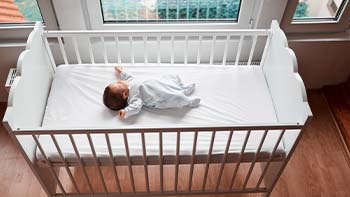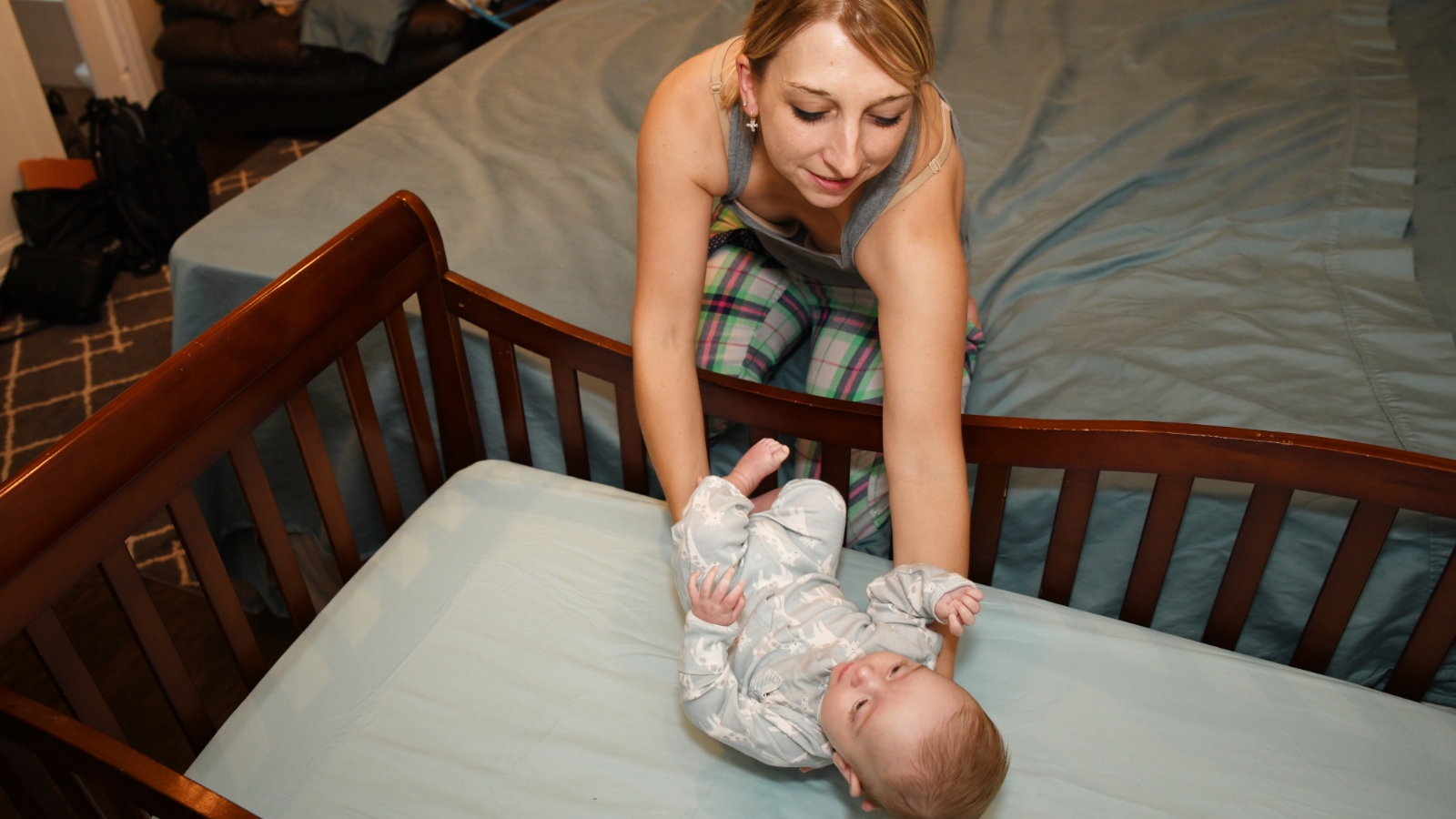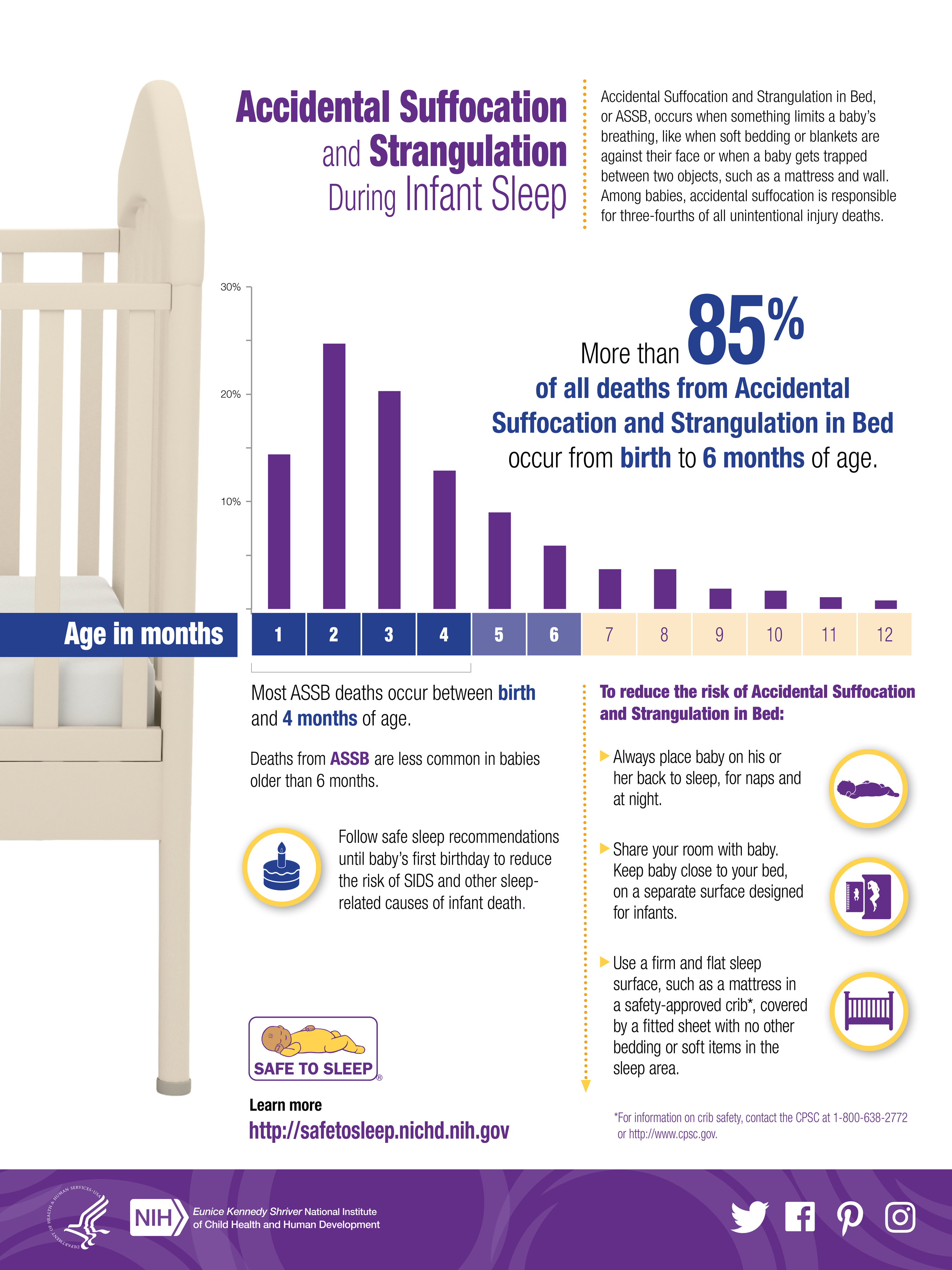 A safe sleep area can help reduce baby’s risk for Sudden Infant Death Syndrome (SIDS) and other sleep-related deaths, such as from accidental suffocation.
A safe sleep area can help reduce baby’s risk for Sudden Infant Death Syndrome (SIDS) and other sleep-related deaths, such as from accidental suffocation.
What does a safe sleep environment look like?
A safe sleep environment for baby is:
- Firm (returns to its original shape quickly if pressed on)
- Flat (like a table, not a hammock)
- Level (not at an angle or incline) and covered only with a fitted sheet
Learn more about safe sleep surfaces and other features of a safe sleep environment.
You can find examples and images of safe sleep areas on our Flickr page. Babies should never sleep on an adult bed, couch, or armchair by themselves, with others, or with pets. Couches and armchairs are particularly dangerous when an adult falls asleep on them while feeding or comforting baby.1
Why does baby’s sleep surface have to be firm, flat, and level?

Although adults may prefer soft surfaces for sleep, research shows that babies who sleep on top of soft surfaces or with items are at higher risk of SIDS and other sleep-related death. Soft surfaces, like couches, sofas, waterbeds, memory foam, air or pillow-top adult mattresses, quilts, blankets, and sheepskins are not safe for babies to sleep on.
Learn more about other sleep-related deaths including entrapment, suffocation, and strangulation.
Sleeping under quilts, blankets, sheepskins, and other soft coverings also increases the risk of sleep-related infant death from suffocation and strangulation.
Sleep surfaces with one end higher than the other are not safe for babies to sleep on, because baby’s body can slide down and their head can slump forward. This can cause positional asphyxia, which is when baby’s body position gets in the way of their breathing.
Similarly, sleep surfaces that elevate both baby’s head and feet, like a hammock, also increase the risk for positional asphyxia. Sitting with the head down and the chin on or near the chest could block baby’s airway and cause suffocation.
For these reasons, baby’s sleep surface should be firm (returns to its original shape quickly if pressed on), flat (like a table, not a hammock), and level (not at an angle or inclined).
Can I put a pillow, blanket, or a favorite toy in baby’s sleep area?
Even though a crib with nothing in it except a fitted sheet covering the mattress may seem bare, it is the safest option for baby.
Things in the sleep area can pose dangers for baby, especially if they are:
- Soft or squishy (e.g., pillows, stuffed toys, crib bumpers)
- Under or on top of baby (e.g., comforters, quilts, blankets, positioners)
- Non-fitted, even if they are lightweight, small, or “tucked in” (e.g., loveys/cloths, non-fitted sheets, tucked-in blankets)
- Weighted (e.g., weighted blankets, weighted swaddles)
Research also links crib bumpers and bedding other than a fitted sheet covering the baby’s mattress to serious injuries and deaths from SIDS, suffocation, entrapment, and strangulation.
Keeping these things out of baby’s sleep area is the best way to avoid these dangers.
Is it safe for my baby to sleep in a car seat or stroller?
Car seats, strollers, and sitting devices are not recommended as baby’s regular sleep or nap space. If baby falls asleep in a sitting or carrying device, move them to their regular sleep space as soon as possible.
What is room sharing, and how do I do it?

Room sharing means that baby sleeps in the same room as parents or adults, near or next to the adult bed, but in a separate sleep space that is made for infants (crib, bassinet, or portable play yard).
Research shows that room sharing reduces the risk of SIDS and sleep-related infant deaths. It is safer than bed sharing and is safer than having baby sleep in their own room.
Some data suggest that room sharing reduces the risk of SIDS by as much as 50% compared with sharing an adult bed with baby or sleeping in a separate room from baby.1 Room sharing without bed sharing also reduces the risk of suffocation, strangulation, and entrapment, any of which can occur when a baby sleeps in an adult bed.
Room sharing also makes feeding, comforting, and monitoring the baby easier. For example, keeping a baby in a safety-approved crib* next to the adult bed makes it easier to check on baby without having to get fully out of bed. An infant sleep space next to mom’s side of the bed also means she can breastfeed without having to go in another room.
What should I do if I fall asleep while feeding or comforting baby in my bed?
If you fall asleep while feeding or comforting baby in your bed, put them back into their own sleep area, like a bassinet, next to your bed as soon as you wake up.
You should also think about how tired you are before you bring baby into your bed to feed or comfort. If there’s a chance you may fall asleep, remove all items and bedding from your side of the bed before adding baby to the bed. Removing pillows, blankets, and unfitted sheets from the area reduces the risk of suffocation and strangulation for baby.
Learn more about ways to practice safe sleep when breastfeeding.
Won't I be able to better protect my baby from SIDS by bed sharing with them/having them sleep in my bed?
Bed sharing—when baby shares a sleep surface with an adult, other child/children, or pet—is not recommended, because it increases the risk for SIDS and sleep-related death. Babies should not share an adult mattress, couch, or armchair with others, or with pets.
Many people think they will be able to hear or sense SIDS before it happens and take action to save baby. But SIDS is not associated with sounds or movements, meaning there is usually nothing to hear or sense.
Bed sharing can also be very risky for baby in certain situations. Room sharing without bed sharing is the safest option.
Learn more about safe sleep surfaces and other features of a safe sleep environment.
* The Consumer Product Safety Commission has more information on crib safety at https://www.cpsc.gov/SafeSleep.


